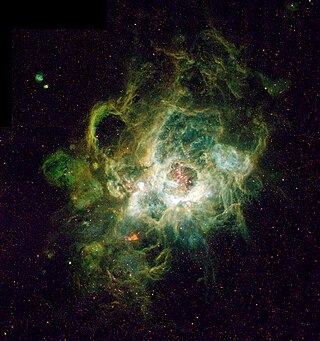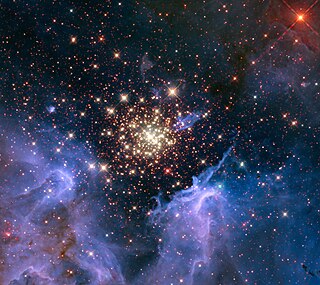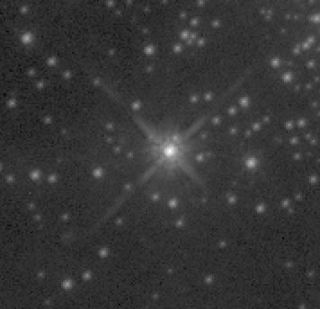
An H II region or HII region is a region of interstellar atomic hydrogen that is ionized. It is typically in a molecular cloud of partially ionized gas in which star formation has recently taken place, with a size ranging from one to hundreds of light years, and density from a few to about a million particles per cubic centimetre. The Orion Nebula, now known to be an H II region, was observed in 1610 by Nicolas-Claude Fabri de Peiresc by telescope, the first such object discovered.

The Tarantula Nebula is a large H II region in the Large Magellanic Cloud (LMC), forming its south-east corner.

Luminous blue variables (LBVs) are massive evolved stars that show unpredictable and sometimes dramatic variations in their spectra and brightness. They are also known as S Doradus variables after S Doradus, one of the brightest stars of the Large Magellanic Cloud. They are extraordinarily rare, with just 20 objects listed in the General Catalogue of Variable Stars as SDor, and a number of these are no longer considered LBVs.

Sher 25 is a blue supergiant star in the constellation Carina, located approximately 25,000 light years from the Sun in the H II region NGC 3603 of the Milky Way. It is a spectral type B1Iab star with an apparent magnitude of 12.2. Its initial main sequence mass is calculated at 60 times the mass of the Sun, but a star of this type will have already lost a substantial fraction of that mass. It is unclear whether Sher 25 has been through a red supergiant phase or has just evolved from the main sequence, so the current mass is very uncertain.

R136 is the central concentration of stars in the NGC 2070 star cluster, which lies at the centre of the Tarantula Nebula in the Large Magellanic Cloud. When originally named it was an unresolved stellar object but is now known to include 72 class O and Wolf–Rayet stars within 5 parsecs of the centre of the cluster. The extreme number and concentration of young massive stars in this part of the LMC qualifies it as a starburst region.

R136b is a Wolf–Rayet star in the R136 cluster in the Large Magellanic Cloud. It is one of the most massive and most luminous stars known. It is found in the dense R136 open cluster at the centre of NGC 2070 in the Tarantula Nebula.

R136a1 is one of the most massive and luminous stars known, at 196 M☉ and nearly 4.7 million L☉, and is also one of the hottest, at around 46,000 K. It is a Wolf–Rayet star at the center of R136, the central concentration of stars of the large NGC 2070 open cluster in the Tarantula Nebula in the Large Magellanic Cloud. The cluster can be seen in the far southern celestial hemisphere with binoculars or a small telescope, at magnitude 7.25. R136a1 itself is 100 times fainter than the cluster and can only be resolved using speckle interferometry.

Melnick 42 is a massive blue supergiant star in the Tarantula Nebula in the Large Magellanic Cloud located in the constellation Dorado. Although it is only 21 times the size of the sun, its high temperature of 47,300 K makes it one of the most luminous stars of the Tarantula Nebula at 3,600,000 L☉. It is less than two parsecs from the centre of the R136 cluster, although that is well outside the central core.

VFTS 682 is a Wolf–Rayet star in the Large Magellanic Cloud. It is located over 29 parsecs (95 ly) north-east of the massive cluster R136 in the Tarantula Nebula. It is 138 times the mass of the sun and 3.2 million times more luminous which makes it one of the most massive and most luminous stars known.

VFTS 102 is a star located in the Tarantula nebula, a star forming region in the Large Magellanic Cloud, a satellite galaxy of the Milky Way.

R136a2 is a Wolf-Rayet star residing near the center of the R136, the central concentration of stars of the large NGC 2070 open cluster in the Tarantula Nebula, a massive H II region in the Large Magellanic Cloud which is a nearby satellite galaxy of the Milky Way. It has one of the highest confirmed masses and luminosities of any known star, at about 151 M☉ and 3.5 million L☉ respectively.

R136c is a star located in R136, a tight knot of stars at the centre of NGC 2070, an open cluster weighing 450,000 solar masses and containing 10,000 stars. At 142 M☉ and 3.8 million L☉, it is the one of the most massive stars known and one of the most luminous, along with being one of the hottest, at over 40,000 K. It was first resolved and named by Feitzinger in 1980, along with R136a and R136b.
HD 38282 is a massive spectroscopic binary star in the Tarantula Nebula, consisting of two hydrogen-rich Wolf-Rayet stars.

R136a3 is a Wolf–Rayet star in R136, a massive star cluster located in Dorado. It is located near R136a1, the most massive and luminous star known. R136a3 is itself one of the most massive and most luminous stars known at about 179 times more massive and 5 million times more luminous than the Sun.

BI 253 is an O2V star in the Large Magellanic Cloud and is a primary standard of the O2 type. It is one of the hottest main-sequence stars known and one of the most-massive and most-luminous stars known.

Melnick 34, also called BAT99-116, is a binary Wolf–Rayet star near R136 in the 30 Doradus complex in the Large Magellanic Cloud. Both components are amongst the most massive and most luminous stars known, and the system is the most massive known binary system.
BAT99-98 is a star in the Large Magellanic Cloud. It is located near the R136 cluster in the 30 Doradus nebula. At 226 M☉ and 5,000,000 L☉ it is one of the most massive and luminous stars known.

VFTS 352 is a contact binary star system 160,000 light-years (49,000 pc) away in the Tarantula Nebula, which is part of the Large Magellanic Cloud. It is the most massive and earliest spectral type overcontact system known.

VFTS 243 is an O7V type main sequence star that orbits a stellar mass black hole. The black hole is around nine times the mass of the Sun, with the blue star being 25 times the mass of the Sun making the star 200,000 times larger than the black hole. VFTS 243 is located in the Large Magellanic Cloud inside NGC 2070 around 160,000 light years from Earth. The binary has an orbital period of 10.4 days.













